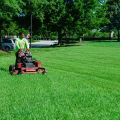Ensure Timely Care With Mandarin Tree Service!
Nectarine is a fantastic fruit with a juicy taste. Pruning nectarines is an essential part of tree care. There are several reasons to downsize a nectarine tree, each with a specific purpose. It will ensure a long tree life and a bountiful harvest for the grower. Learn when and how to prune nectarine trees.
When To Prune Nectarine Trees?
Most fruit trees are pruned during the dormant period or in winter. Nectarines are an exception. They should be pruned at the end of early spring so that the survival rate of flowers to bud can be accurately estimated before pruning. Pruning and training of nectarines should begin in planting and then every year to create a robust and balanced foundation of forests.
The purpose of pruning a nectarine tree is to control its size to make it easier to care for and collect fruit. Pruning also helps develop a strong branch structure and opens up the tree so that sunlight can enter through the crown. It is also essential to remove excess fruitwood, encourage budding, and remove dead, broken, or crossed branches.
How To Prune Nectarine Trees?
There are several methods of pruning fruit trees. The preferred method of growing nectarines is an open-center system that opens the tree to sunlight and promotes maximum yield with the highest quality fruit. The goal is to create a strong trunk and well-placed side branches while balancing vegetative growth and fruit production.
Once you've planted the tree, trim it down to about 26-30 inches (65-75 cm) tall. Trim all side branches to leave the shoot without side branches 26-30 inches (65-75 cm) high. This is called pruning to the whip. It looks radical, but it creates a tree with an open center of the best shape.
In the first year, remove all diseased, broken, or low-hanging limbs, as well as all erect shoots that develop on the mainframe. In the second and third year, eliminate all diseased, damaged, or low-hanging branches again, as well as vertical shoots that grow on the inside of the tree. Leave smaller shoots for fruit production. Trim the strong, erect branches on the scaffolding, cutting them down to the outward-growing shoot. Continue in this vein annually, pruning first low-hanging, broken, dead limbs and then vertical shoots along the scaffolding. Finally, reduce the tree’s height by pruning the structure to an outward-growing shoot at the desired size.
It is beneficial to avail of the tree services in North East Florida. They have the necessary tools, qualified and experienced workforce, and technologies to work in all weather conditions and trim nectarine trees professionally. They achieve better results, help plants grow faster, and allow farmers to get high yields. It is always easier to find professional tree-cutting services. Recommendations from friends, neighbors, Internet searches are helpful.





